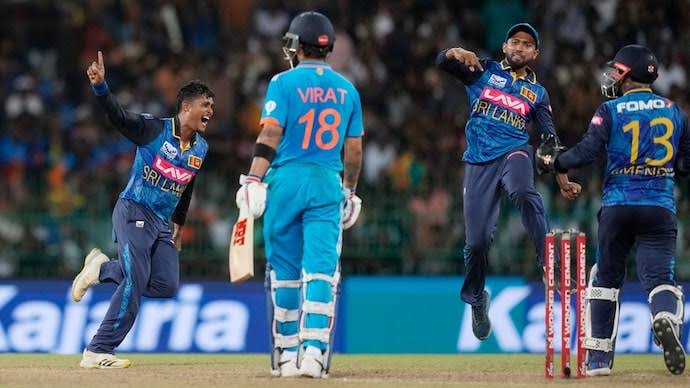Spinners became India’s worst nightmare in their first bilateral series defeat against Sri Lanka since 1997. Sri Lanka had the opportunity to bowl second in the three ODIs, and their spinners made the most of the turning conditions that were on offer in Colombo.
The story was the same for Indian batters throughout the ODI series, as they fell short against Sri Lanka spinners while chasing a target between 240-250 runs. Spinners remained the root cause of trouble for the Indian batters.
In the first game that ended in a draw, Sri Lanka spinners combined picked up nine wickets.
In the second game, Jeffrey Vandersay welcomed the Indian batters to witness his art in spin craft. He laid out a spin trap that Indian batters couldn’t escape from. His six-wicket haul left India bamboozled, and skipper Charith Asalanka’s three-fer completely knocked the visitors out of the game.
In the third ODI, Sri Lanka spinners once again scripted a painful outing for India with the bat. Once again, a different spinner made Indian batters look out of their depth.
Dunith Wellalage, a primary concern for India in Sri Lanka’s tail end, picked up a five-wicket haul in his 5.1 over spell.
India’s mainstays, skipper Rohit Sharma, Virat Kohli, Shreyas Iyer and Axar Patel, perished in front of Wellage’s slow left-arm orthodox style of spin.
In all, India lost a staggering 27 wickets to spin in the ODI series, which is the most by any team in a bilateral ODI series with a maximum of three matches.
The real tragedy, though, wasn’t in the result but the appalling loss of competition that reduced this series into a walkover. For all the attacking verve Rohit Sharma has tried to inject in each of the three ODI chases, not once has India’s middle-order been able to temper the quick starts with the level of skill that could thwart Sri Lanka’s spinners. Only Sharma, Virat Kohli and the spunky Washington Sundar could cross 20 as six batters were dismissed for single digits. India are No.1 in ODI rankings, but this defeat told a different story as India were schooled by spinners in a hark back to the 1990s.
The capitulation to spin must ruffle a few feathers. If it was Jeffrey Vandersay who broke India’s resistance with six wickets in the second ODI, on Wednesday it was Dunith Wellalage’s turn with five wickets. There was no plan against spin, just the odd show of defiance or innovation when ideally batters should have turned to grafting the gettable run rate. Failure to do so for three matches in a row points to an inexplicable nosedive of technical and mental prowess in the space of a week.
So shambolic has been India’s batting that perhaps only Sharma can escape scrutiny. Shubman Gill averaged 19, ending this series being bowled, missing a wild slog after charging down the pitch. Brought in place of KL Rahul, Rishabh Pant departed in similar fashion — skipping down the track to Maheesh Theekshana who pulled the length back and beat his outer edge so comprehensively that his stumping could easily be mistaken as a run out. Unprecedented too has been the form of Kohli, who averaged 19.33 in three matches — his lowest in seven bilateral ODI series against Sri Lanka.
Neither Axar Patel nor Shreyas Iyer could read the ball off the hand or the pitch to be bowled and trapped leg-before respectively. Nothing however summed up India’s ignominy more aptly than the dismissal of Riyan Parag in the 3rd ODI, looking far from a debutant till he shouldered arms to a good length ball from Vandersay that didn’t turn and clattered into his middle stump. Washington’s feisty cameo ensured it wasn’t a complete surrender but it was only delaying the inevitable after India’s batting spine had been systematically dismantled.







